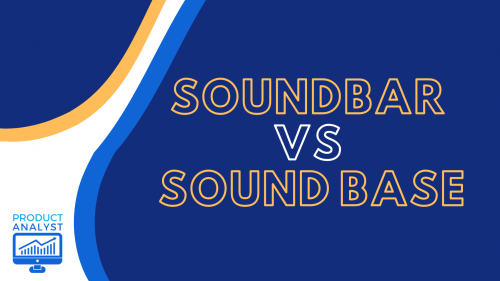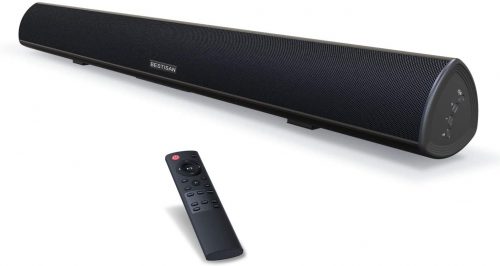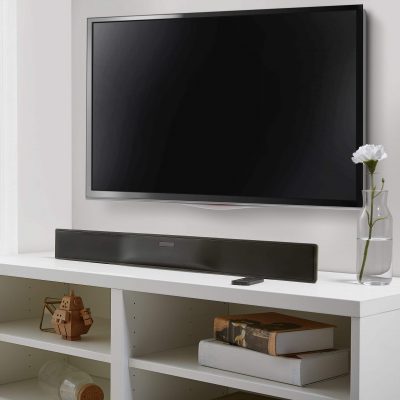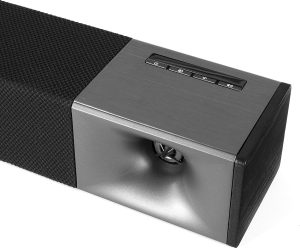
If you want to enhance the sound of your TV without the additional speakers or room requirements of a full surround sound setups, soundbars and soundbases are your best options. But are they enough, or will they be money down the drain? Our experts would give you the information that you will be needing between the advantages and disadvantages of a soundbar vs soundbase.
Soundbar vs Sound Base
Soundbars and soundbases vary in terms of style, sound, and placement. Sound bars are long and slender devices that are commonly fixed and have a few internal speakers as well as an external sub. Soundbases are smaller, lie behind the TV, and have more internal speakers. So, which is better and what are the reasons? Let’s find out.
Soundbar
Sound bars are long, slim loudspeakers that can be mounted above or below a television or display. They’re cost-effective, and they’re getting close to matching the sound dispersion quality of surround sound systems these days.

Dolby True HD and DTS Master Audio processing are often included in many soundbars and support Bluetooth streaming. Since the bar’s own speakers are not capable of delivering heavy bass, most soundbars come with separate subwoofers.
Pros
- Decent option for simple audio entertainment
- More versatile - can be wall-mounted or placed on the stand in front of the TV
- Ideal in a small space/media room setup
- Smart technology features and integrations for TVs
- Includes drivers for handling high and low frequencies
Cons
- Tightens up space within the enclosure due to its slim and narrow build
- Must include external home theater speakers to produce a better and louder audio quality
- Need to pay more for extra parts
Sound Base
Sound bases are meant to be placed on a table or cabinet under the tv. Soundbases are designed to have superior sound quality than the TV’s internal speakers while being cost-effective and easy to mount.

Soundbase usually has larger speaker drivers, more built-in amplification, and the ability to use a bass driver. Furthermore, since no separate subwoofer is needed, the soundbase can take up less room.
Pros
- Very good option if a TV is not wall mounted
- Does not need an A/V receiver
- Less expensive than a 5.1 sound systems for TVs
- Does not need external speakers unless you want them
- Provides a more immersive audio experience
Cons
- Cannot be mounted to a wall
- They can't bounce audio to fill a room as much as a good sound bar
- More expensive than a sound bar
Buying Guide
Optical Digital Audio Input
Both soundbar systems and soundbases offer digital optical connections to the ARC port (audio return channel) on your TV, which will result in high-def sound. Some would have HDMI as well as stereo analog inputs. HDMI is a good option, so look for it. A home entertainment system can have Dolby and DTS audio processing built-in.
Design
Sound bars are normally a few feet long to accommodate the width of your TV and have a sleek, thin build. They are also elegant and fashionable. They are always mounted, so they are seen daily. Soundbases are small in size and lightweight, often with a narrower diameter than a sound bar. They are, however, thicker and sturdier since they are intended to be used with a TV on top of them.

Speaker Configuration
When choosing what to buy between soundbars vs soundbases, one thing to consider is the speaker configuration. Soundbases usually have a 2.1 or 3.1 speaker arrangement, which means they have a left and right speaker as well as a subwoofer, or a left, right, and middle channel speaker as well as a subwoofer.
On the contrary, soundbars typically have three to five internal speakers, but some of the newest models on the market have seven or eight internal speakers to boost audio clarity to cope with standard speaker systems in your home theater setup. They can have a built-in subwoofer or internal technology to boost the bass.
Placement
The placement for sound bases is very limited. They can only be placed at the base or top of your TV, or sit on a TV stand, cabinet, or entertainment stand – mounting is not a viable option. While soundbars are more versatile as they can be mounted on a wall, which is a big advantage and something to consider for people with small spaces.

Sound Quality
Audio quality is also a vital feature you need to consider when buying. A soundbase is not as big as a sound bar, but it has a lot of space within the enclosure. Soundbases with more capacity will have larger internal speakers, amplifiers, and subwoofers, resulting in more efficient audio without the need for additional tv speakers.
A sound bar, on the other hand, can have a more room-filling surround sound thanks to a broader audio landscape, but the bass drivers will often be a letdown. Soundbars usually need an external subwoofer for pronounced bass, although there are several alternatives on the market for high-quality built-in subwoofers.
Compatibility
It’s worth noting the difference in compatibility and styles of a soundbar vs sound base. They have different extra features, such as Bluetooth connectivity, smart home platform compatibility, and more. Furthermore, they provide a variety of wired networking choices, including HDMI, analog, optical, and even RCA[1] that can impact your purchase decision.
One other difference between a soundbar and soundbase is some soundbars already come with wireless connectivity for streaming. You just need to pair other Bluetooth or Wi-Fi supported devices, to enjoy seamless access to your music library in multiple rooms.
Pricing
Money is always a factor that needs consideration whenever you’re choosing to buy between soundbars vs soundbase. When it comes to pricing, sound bases are the kind of equipment that is a bit more expensive versus soundbars because fewer manufacturers are making them.

To be fair, an expensive soundbase will outperform a low-cost sound bar, and vice versa, so work out the budget and compare similarly priced pieces. Pricing usually runs between $100 and $500 up depending on brand and overall quality.
FAQ
Is a sound bar better with a subwoofer?
No, a sound bar isn’t better with a subwoofer. At least, not all of the time. Soundbars have many internal speakers that can produce high-quality audio on their own, but as per our experts’ advice, subwoofers can produce low-frequency audio that many soundbars cannot.
How much should I spend on a soundbars?
You should spend what you can on a soundbar while being considerate of your budget. You could spend as low as $100 to find a good quality soundbar, one that could produce awesome audio quality. They can also feature extra advantages such as sound modes, and many advanced audio format decoding abilities.
Do watts matter in a soundbar & sound base?
No, the wattage doesn’t matter when it comes to how the soundbar or soundbase would produce quality audio. The overall number of watts has no bearing on the performance of the device involved.
Conclusion
A high-end soundbar will outperform a low-cost soundbase, and vice versa. However, the best solution for you will eventually be determined by your budget and personal preference. Some prefer a lot more bass for their surround sound system, while others prefer a crisper and clearer tone.
The post Sound Base vs Soundbar — Which Speaker Style is Better? appeared first on The Product Analyst.
from The Product Analyst https://theproductanalyst.com/soundbar-vs-sound-base/
No comments:
Post a Comment